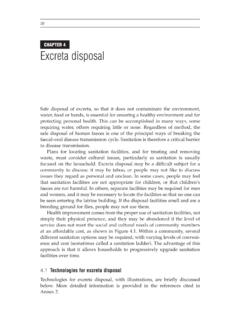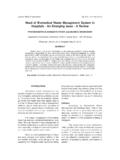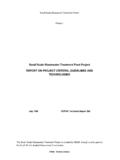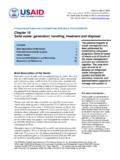Transcription of Dissolved Air Flotation in Industrial Wastewater …
1 UNESCO EOLSSSAMPLE CHAPTERSWATER AND Wastewater treatment technologies - Dissolved Air Flotation in Industrial Wastewater treatment - A. Srinivasan and T. Viraraghavan Encyclopedia of Life Support Systems(EOLSS) Dissolved AIR Flotation IN Industrial Wastewater treatment A. Srinivasan and T. Viraraghavan Faculty of Engineering, University of Regina, Canada Keywords: Dissolved air Flotation , principles, Industrial Wastewater , applications. Contents 1. Introduction 2. Process configurations 3. Developments in DAF 4. Principles of DAF Gas-Water Equilibrium Rate of Gas Transfer Bubble Formation Bubble Size Bubble Particle Interaction Bubbles Supplied 5. Design considerations Influent Feed Characteristics Air-To-Solids Ratio Hydraulic Loading Rate Solids Loading Rate Surface Area Pressurization System Operating Pressure Quantity of Pressurized Flow Chemical Usage 6.
2 Design criteria 7. Applications in Industrial Wastewater treatment Petroleum Refinery Vegetable Oil Industry DAF Studies on Oil-In-Water Emulsions Mining and Mineral Processing Industries Slaughterhouse Other Food Processing Industries Other Industries Glossary Bibliography Biographical Sketches Summary Dissolved air Flotation (DAF) has been successful in treating Industrial wastewaters. In many cases, such as in poultry effluent treatment , DAF proves to be an effective pre- treatment technology by reducing the organic load of the Wastewater . DAF units have UNESCO EOLSSSAMPLE CHAPTERSWATER AND Wastewater treatment technologies - Dissolved Air Flotation in Industrial Wastewater treatment - A. Srinivasan and T. Viraraghavan Encyclopedia of Life Support Systems(EOLSS) been widely in use in treating refinery and mining industry effluents. In both the cases DAF combined with chemical flocculation has proven to be very effective in removing particles from the effluents.
3 Thus, DAF should not be considered as a separate process, but integrated into design and operation of the overall treatment system. Recent technological advances in DAF include DAFR apide, AquaDAF and high rate DAF. DAF is considered as one of the most powerful tools to remove light and difficult-to-treat colloidal suspensions, precipitates or fine dispersions. 1. Introduction Dissolved air Flotation (DAF) is a process for removing suspended particles from liquid by bringing particles to the surface of the liquid. The influent feed liquid can be raw water, Wastewater or liquid sludge. The Flotation system consists of four major components: air supply, pressurizing pump, saturator (retention tank), and Flotation chamber. According to Henry s law, the solubility of a gas in an aqueous solution increases with increasing pressure.
4 Air is Dissolved in the Wastewater at high pressure in a saturator, and microbubbles are formed when water is released in the Flotation cell at atmospheric pressure. The influent feed stream may be pressurized by means of a pressurizing pump to 172-620 kPa with compressed air added at the pump suction. The pressurized stream is held in a retention tank at this high pressure for about to 30 min to allow sufficient time for the air to dissolve into the feed stream. It is then admitted through a pressure reducing valve to the Flotation chamber. The sudden reduction in pressure in the Flotation chamber results in the release of microbubbles. The microbubbles become attached to suspended or colloidal particles in the process water increasing their buoyancy and allowing them to rise to the surface to form a floted layer. The vertical rise rate of air bubbles range from to m/min.
5 Flight scrapers or other skimming devices continuously remove the float material. The effluent from DAF is drawn from the bottom of the Flotation chamber for reuse or discharge (Figures 1-3). Figure 1. Full flow Dissolved air Flotation UNESCO EOLSSSAMPLE CHAPTERSWATER AND Wastewater treatment technologies - Dissolved Air Flotation in Industrial Wastewater treatment - A. Srinivasan and T. Viraraghavan Encyclopedia of Life Support Systems(EOLSS) Figure 2. Partial flow Dissolved air Flotation without recycle Figure 3. Recycle flow Dissolved air Flotation 2. Process Configurations Three operating configurations are available for DAF systems. These are as follows: Full-flow pressure Flotation , where the entire influent stream is pressurized and then released in the Flotation tank where the bubbles are formed (Figure 1). This is commonly used for feed streams with suspended solids exceeding 800 mg/L, which do not need flocculation but require large volumes of air bubbles.
6 Partial flow pressure Flotation without recycle system, where part of the influent stream (about 30-50%) is pressurized and directly introduced to the Flotation tank (Figure 2). The remaining portion of influent stream is fed by gravity or low-pressure pump to Flotation chamber. This is employed in applications where suspended particles are at a low concentration and thus have a low air requirement. Recycle-flow pressure Flotation , where a portion of treated Wastewater (about 15-50%) is pressurized and recycled to the Flotation tank (Figure 3). This is generally employed where coagulation and flocculation are part of the treatment system. This alternative is most common in Wastewater treatment including oil removal. 3. Developments in DAF UNESCO EOLSSSAMPLE CHAPTERSWATER AND Wastewater treatment technologies - Dissolved Air Flotation in Industrial Wastewater treatment - A.
7 Srinivasan and T. Viraraghavan Encyclopedia of Life Support Systems(EOLSS) The first generation DAF systems used in the treatment industry were tanks in which the Flotation phenomenon occurred. The flow rate of water was approximately 2-3 m/h (not higher than 5 m/h). The second generation of DAF was introduced in the 1960s and these units are widely in use today. The designs of these plants were typical of early DAF plants, with surface loading rate below 5-7 m/h and flocculation times as high as 45 min. An in filter DAF process was developed in late 1960s, wherein Flotation occurs directly above the filter. This process is known as Dissolved air Flotation /filtration (DAFF). The third generation of DAF has been developed at the end of the 1990s. The operational idea is based on that of DAFF. Recent advances include technology such as counter-current Dissolved air Flotation filtration (CoCoDAFF).
8 CoCoDAFF introduces the recycle flow above the filter media through special high volume flow rate nozzles that are designed to widely disperse the bubbles. Other recent technologies include DAFR apide, which combines reduced flocculation times with Flotation loading rates up to 40 m/h and AquaDAF which can achieve surface loading rates up to 40 m/h and high rate DAF. 4. Principles of DAF The DAF system has four process phases: 1. Gas transfer across the air-water interface in a saturator tank; 2. Gas precipitation. Air in the Dissolved state precipitates to form gas bubbles; 3. Transport of gas bubbles to solid particles to achieve contact and then attachment ; and 4. Flotation of the bubble-particle agglomerate in a Flotation chamber. Gas-Water Equilibrium The gas-phase-aqueous-phase equilibrium is given by Henry s law. Henry s law states that the aqueous concentration of Dissolved gas of a species is proportional to the partial pressure of that species in the gas phase.
9 It is given by the equation: ..AATCHxP= (1) where CA = Concentration of Dissolved gas A in aqueous solution (kg/m3) H = Henry s constant (kg/m3/kPa) xA = mole fraction of gas A in gas phase PT = Total pressure of all gases (kPa) The Dissolved gas concentration leaving the saturator is always less than the equilibrium level as stated by Henry s law. The rates of these two values is the efficiency factor, f. Thus the modified form of Henry s law for a saturator becomes, ..AATCfHxP= (2) where f = ratio of gas concentration leaving saturator to gas concentration predicted by Henry s law.
10 For packed saturator, f ~ and for unpacked saturators, f ~ UNESCO EOLSSSAMPLE CHAPTERSWATER AND Wastewater treatment technologies - Dissolved Air Flotation in Industrial Wastewater treatment - A. Srinivasan and T. Viraraghavan Encyclopedia of Life Support Systems(EOLSS) Rate of Gas Transfer The rate of gas transfer across an interphase from gas phase to Dissolved phase is proportional to the saturation deficit. ()LSrdCKaC Cdt = (3) Where rdCdt = rate of change of Dissolved gas concentration (kg/m3/s) t = time elapsed (s) KLa = mass transfer coefficient (sec-1) CS = saturation concentration (kg/m3) C = concentration of gas in aqueous phase at time t (kg/m3) Mass transfer coefficient KLa = (D/ ) (A(air-water interphase)/V(saturator)) Where D = diffusion constant for Dissolved gas in water (m2/s) = film thickness (m) A (air-water interphase) = air-water interfacial area in saturator packing (m2) V (saturator) = volume of saturator packing (m3)

















